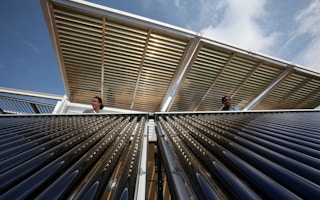Increasing U.S. use of renewable energy is a core component of Hillary Clinton’s campaign platform. She contends that this shift will create jobs and make the United States the world’s 21st-century clean energy superpower.
Given Clinton’s strong record on gender equality, we (two women involved in research and advocacy on diversity in the energy sector) are perplexed that her energy and climate plan does not yet prioritize empowering women. We see huge benefits in targeting new energy job opportunities for women and women of color.
Other industries, such as the financial sector, have already learned that gender diversity can foster innovation and enhance productivity. The energy sector is rapidly transitioning from fossil fuels to renewables. Harnessing gender equity would help energy companies promote sustainability and involve the public more directly in energy system change.
The gender gap in energy
The energy sector’s gender gap is glaringly large. Data are scant, but the few studies that exist are revealing. Compared to eight other global industries, ranging from financial companies to health care to technology, the energy sector ranks dead last for gender diversity on corporate boards.
Women’s employment rates in wind, solar and other renewable energies are only slightly higher than in traditional fossil fuels. A survey of 90 renewable energy companies by the International Renewable Energy Association (IRENA) found that 35 percent of employees were women, compared to 20-25 percent of the workforce in the overall energy industry.
Similar studies have found that women who work in renewable energy companies largely hold administrative and public relations positions.
Only 16 percent of board members at the world’s 200 largest electric utilities are women. In 10 countries surveyed by the U.S. Agency for International Development, women made up 13 percent of employees in utilities.
According to a recent report by the Department of Energy (DOE) on the energy sector’s workforce needs, women hold 21 to 25 percent of jobs in the U.S. energy industry, compared to 47 percent of the overall work force. Minorities are similarly underrepresented.
The report also states that energy companies will add thousands of new jobs in 2016, but more than two-thirds of them had trouble hiring qualified employees in the past 12 months. In this rapidly changing industry, there are clearly opportunities for expanding training programs to prepare workers with the needed skill sets.
Why are there so few women in the energy sector? Factors include a male-dominated workplace culture and the common but outdated perception that only men can successfully perform technical and construction jobs. In many countries, from Canada to Mozambique, there is a limited pipeline of women studying engineering and technology. For example, in the United States few women train to be electricians, a key job in the energy sector.
As in other industries, women at energy companies face gender bias in hiring and promotion, and struggle with workplace policies that are unfriendly to women and families, such as inadequate paid parental leave. There is little information that breaks down female employment in the energy sector by race or ethnicity.
However, it has been well documented since the mid-1970s that women of color face a double bind in science, technology, engineering and math-related professions, meaning they are underrepresented in terms of both sex and race or ethnicity.
“
Why are there so few women in the energy sector? Factors include a male-dominated workplace culture and the common but outdated perception that only men can successfully perform technical and construction jobs.
Opportunities for women in the renewable energy transition
The rapid transformation occurring in energy is a window of opportunity to reach out to women. Doing so will provide broad benefits to society and the economy.
For example, studies show that companies with more diverse leadership are more productive. According to McKinsey & Company, companies in the top quartile for gender diversity are 15 percent more likely to have financial returns above their national industry medians.
Fortune 500 companies in the United States with the highest representation of women on their boards (19 to 44 percent women) generate 16 percent higher net income as a percentage of revenue than companies without such representation.

Students from California State University-Chico explain their business plan to judges in the Department of Energy’s 2016 Collegiate Wind Energy Competition. Image:Dennis Schroeder, National Renewable Energy Laboratory/Flickr
We also know that hiring more women boosts economic activity. National economic competitiveness correlates strongly with levels of gender equality. In a recent report, McKinsey estimated that if women achieved full parity with men in labor markets, global economic growth could increase by US$12 trillion by 2025.
More sustainable, more inclusive
Closing the energy gender gap can also accelerate the transition to more sustainable and renewable energy systems. Research shows that having a more diverse workforce leads to more – and more radical – innovation.
Involving women generally leads to decisions that are better for the environment. In industrialized countries, women are more likely than men to express environmental concern, support environmental protection and engage in environmentally friendly behavior. Companies with more women on their board are more likely to proactively invest in renewable energy and reduce carbon emissions throughout their supply chain.
Project manager Mallory Lindgren explains how she uses GIS software to site renewable energy projects.
Greater participation by women can also promote more inclusive decision-making. Researchers have found that effective cooperation in groups is linked to the number of women involved. They attribute this to women’s strength at reading nonverbal cues and encouraging greater participation by their peers.
And energy companies have much to learn from women’s perspectives. Since women are often responsible for household decision-making on energy choices, hiring more women could help companies understand their customers and be more responsive to them.
Customers have more options for getting and using energy now then they did 10 or 20 years ago, and the more that energy companies look like the people they want to serve, the better they will be able to understand their needs and connect with them.
The idea of broader involvement and representation aligns with the emerging notion of “energy democracy” – a movement promoting more local ownership and diverse engagement in distributed renewable energy systems. Employing more women in energy would help distribute the power – literally and figuratively – by involving more different kinds of people.
New thinking for a changing industry
Compared to the challenge of overhauling our energy systems, improving diversity at energy companies is not rocket science. Some U.S. companies are already taking steps in this direction.
SolarCity’s Women in Power group seeks to amplify the voices of the company’s women by sponsoring, supporting and connecting them. General Electric and Cummins have created similar groups in which women help other women develop leadership skills and find opportunities that will advance their careers.
Chevron received the 2015 Catalyst award, which recognizes inclusive leadership, for its work to attract, retain and advance women. And Pacific Gas and Electric Company (PG&E) has invested heavily in woman-owned business enterprises as direct suppliers and subcontractors.
The energy industry has much to gain from expanding opportunities for women at all levels. Diversifying will accelerate innovation, democratize energy decision-making and ownership, and enhance sustainability. Without targeted efforts to hire more women in energy, no country will become the world’s clean energy superpower.
![]()
Rebecca Pearl-Martinez is research fellow & head of Renewable Equity Project at the Fletcher School, Tufts University and Jennie C. Stephens is associate professor of sustainability science and policy, University of Vermont. This article was originally published on The Conversation.











